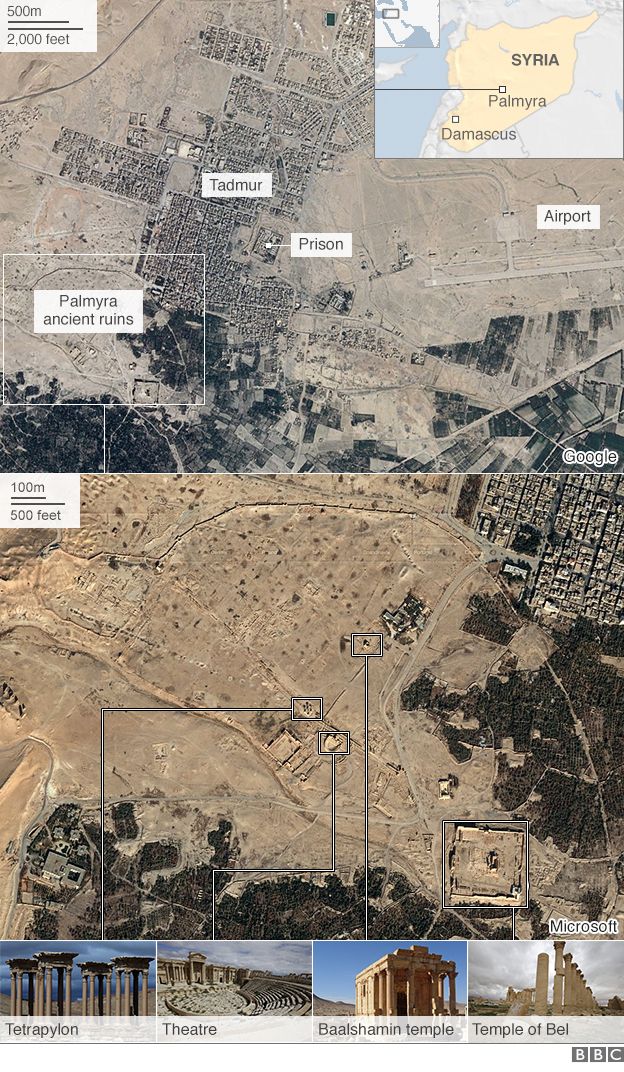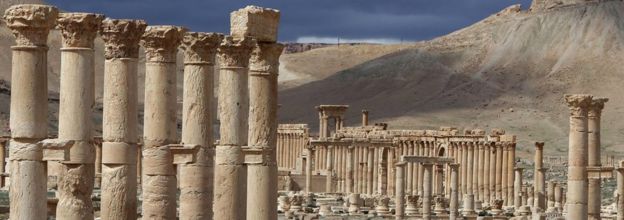- 4 minutes ago
- From the section Middle East
Syrian government forces have re-captured the ancient city of Palmyra from so-called Islamic State (IS), say state media and a monitoring group.
An army representative told Syrian state TV that the recapture of Palmyra marks the beginning of IS' collapse.The Syrian army had been gaining ground for several days, supported by Russian air strikes. Military sources say the army now has "full control".
IS seized the Unesco World Heritage site and modern town in May 2015.
Images released by the Syrian military on Saturday showed helicopters and tanks firing at positions in Palmyra.
The date of the footage could not be independently verified.
The Syrian Observatory for Human Rights, a UK-based monitoring group, said there was still gunfire in the eastern part of the city, but the bulk of the IS force had pulled out and retreated further east.
Why IS militants destroy ancient sites
Palmyra and the logic of loss
In a statement released on Saturday, Russia's defence ministry said the strikes hit 158 IS targets, killing more than 100 militants.
A strategic victory - Sebastian Usher, BBC Arab affairs analyst
The Syrian government and Russian air power threw their full force behind the three-week offensive. The battle for Palmyra may not quite be over, but reports suggest that IS militants have mostly pulled out of the city.The world focus on Palmyra, fuelled by concern over the spectacular ancient ruins on its outskirts, means that this is a major propaganda coup for President Assad and Russia, as well as an important strategic victory.
The Syrian army general command says it shows that the army and its friends are the only force capable of combating and eradicating terrorism. That claim has long rung hollow in Western capitals, but the recapture of Palmyra and the rescue of what remains of its fabled ruins does give it some substance.

Destruction of ancient sites
When IS seized the city it destroyed archaeological sites, drawing global outrage. Two 2,000-year-old temples, an arch and funerary towers were left in ruins.The jihadist group, which has also demolished several pre-Islamic sites in neighbouring Iraq, believes that such structures are idolatrous.
The prospect of the city's liberation was welcomed by Unesco, the UN's cultural agency, which has described the destruction of Palmyra as a war crime.
The head of Syria's antiquities authority, Mamoun Abdelkarim, promised to repair as much of the damage as possible as a "message against terrorism".
Ancient city of Palmyra
 Image copyright AFP/Getty
Image copyright AFP/Getty - Unesco World Heritage site
- Site contains monumental ruins of great city, once one of the most important cultural centres of the ancient world
- Art and architecture, from the 1st and 2nd centuries, combine Greco-Roman techniques with local traditions and Persian influences
- More than 1,000 columns, a Roman aqueduct and a formidable necropolis of more than 500 tombs made up the archaeological site
- More than 150,000 tourists visited Palmyra every year before the Syrian conflict
Why IS destroys ancient sites
Features and Analysis
- Islamic State group: The full story
- Who is Islamic State leader Abu Bakr al-Baghdadi?
- Islamic State: An invincible force?
- Islamic State: What is the attraction for young Europeans?
- What is 'Islamic State'?
- Iraq divisions undermine IS fight
- Counting the cost of air strikes on IS
- Ramadi victory boosts Iraqi forces, but at a price
- Inside the Islamic State kidnap machine
- Islamic State: Where key countries stand

No comments:
Post a Comment